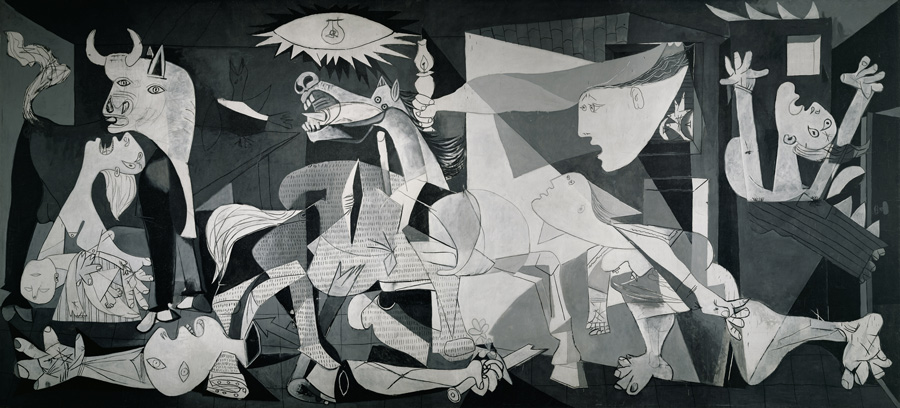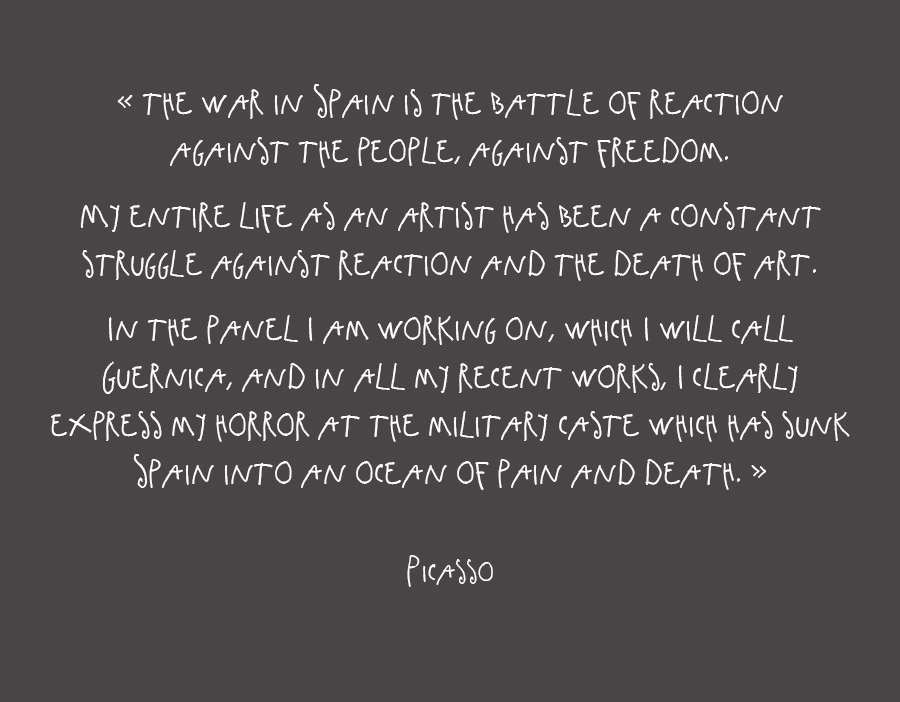Guernica, « Spain into an ocean of pain and death»
On May 24, 1937, the Exposition Internationale des Arts et Techniques opened in Paris. Jean Cassou wrote: “At the famous Expo 37, where the two giants competed - the Soviet building brandishing a hammer and sickle and the German pavilion with its heroic Arno Breker figures - there was a small building, unassuming but admirable in its architectural rigor: the Spanish pavilion. It housed one of the masterworks of universal painting, Guernica, which Picasso, in the burning fury of his genius, had just completed.”[1] The Spanish Civil War became a rallying issue for committed artists, many of whom had already produced works in support of Republican Spain. On April 26, 1937, when the town of Guernica was bombed under Hitler’s orders, the entire world was aghast. Picasso was outraged and furious; moved by powerful resentment, he decided to voice his protest by painting a tribute to the devastated village. Between May 10 and June 4, he covered a monumental canvas with muted colors conveying screams, tears, heartbreak, violence and death, broken women, and dead children. It was therefore this work, described by Christian Zervos as “a pictorial poem of pain,” which he exhibited in the Spanish pavilion with the title Guernica. In the painting, his capacity for observation and his talent for transcribing reality enabled him to express his horror at what was happening in his country of origin. Aesthetics became political and form became a strength. Picasso agreed to have the painting used for propaganda purposes in support of the Republican cause.[2]
A subsequent but undated report from the Préfecture de police states that “Picasso, whose ideas seem to be in favor of extremist doctrines, provided subsidies to the Spanish government during the civil war.” Another claims that “from a political point of view, the person concerned has always expressed a favorable view of left-wing and far-left parties. Accordingly, during the insurrectionary uprising of General Franco, he produced propaganda for the government supporters.”[3] For Picasso, “the war in Spain is the battle of reaction against the people, against freedom. My entire life as an artist has been a constant struggle against reaction and the death of art. In the panel I am working on, which I will call Guernica, and in all my recent works, I clearly express my horror at the military caste which has sunk Spain into an ocean of pain and death.”
Between June and October 1937, as the Nationalist forces advanced, 120,000 Spaniards crossed the Pyrenees seeking refuge in France. By 1939, 500,000 had escaped. On March 28, 1939, when Franco seized power, the death toll had risen to 600,000.[4] The Spanish Civil War was one of the most significant events of the twentieth century.
From the very beginning of the conflict, the French public was presented with exhibitions conveying the harshness of the fighting. Le Midi socialiste provided a report of one of these held at the Foyer du peuple in Toulouse, “L’Espagne en guerre,” featured in the May 10, 1938 issue: “We wanted […] to prove, once again, how necessary it is to help the Spanish Republic effectively if we are to avoid having our country succumb to the hegemony of two warmongers whose doctrines must inevitably lead to war. We must do everything within our power to save as many lives as we can from the dreadful bloodbath that is raging every day across the Pyrenees.”[5] Through a large number of posters, books, leaflets, and photographs taken during the war – the material provided by the General Propaganda Commission of the Catalan Government – the exhibition highlighted the unprecedented violence of the conflict and the times that heralded disasters.
[1] Jean Cassou, Une vie de libertés, éditions Robert Laffont, “vécu” collection, p. 161.
[2] Géraldine Mercier, “Picasso au cœur du réseau d’aides au républicains,” Guernica, exhibition catalogue, p. 223, éditions Musée national Picasso-Paris/Gallimard, 2018.
[3] Archives of the Préfecture de police, file GA 230_204648, op. cit.
[4] Estimate by Hugh Thomas, The Spanish Civil War, London, Eyre & Spottiswoode, 1961; London, Penguin, 2013.
[5] Information provided by Pierre Gastou, municipal archives, Toulouse.






 Summary
Summary